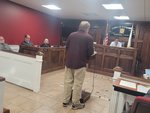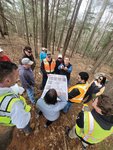

The debate on whether to allow the demolition of 325 acres of woodlands and former farmland for the construction of solar panels in five residential neighborhoods has been myopically and disingenuously framed as a choice between endless parallel rows of solar panels or massive housing developments. There is a third option: Following the town’s Comprehensive Plan, which strongly encourages the preservation of this precious land to maintain a high quality of life for all Johnston residents.
This not-so-veiled threat that housing will overrun this undeveloped land and strain town services, if the solar developments are rejected, is greatly overstated. As an example, the 158-acre parcel on Winsor Avenue that represents the Winsor III solar proposal has been for sale for two years with no takers. I suspect no housing developer has offered to buy the land on which the other four solar projects would sit either. Johnston’s schools and fire and police departments cannot be adversely affected by something that does not exist.
The town Comprehensive Plan specifically acknowledges the 230 or so acres that border Winsor Avenue, Hopkins Avenue, and Rollingwood Drive for its “value for conservation and open space … its predominantly undeveloped state, its proximity to the Scituate [Reservoir] Watershed area … and its location adjacent to the heavily developed and developing area of Hartford Avenue.” Instead of unsightly solar panels, this land could benefit the entire town with the advent of walking trails, family picnic areas, and open space for light recreational use, while simultaneously maintaining the current natural habitat for the deer, fox, wild turkeys, other birds, and foliage that already exist and thrive here.
While Green Development has offered to remove the solar panels and return the land to the town after 20 to 25 years, why should we wait more than two decades to get the properties back after they have already been decimated? Let’s not sugarcoat these proposals. Once these trees and wildlife are gone, it will take more than a few decades after the solar panels are removed to reforest and repopulate this acreage.
Can the town afford to pay for and maintain the preservation of this land? Town Councilman Robert J. Civetti told the town Planning Board at its March 3rd meeting that Johnston has a $38 million budget surplus. While not all of these funds should be allocated for such an initiative, a portion of the money would be an excellent start to the process of nature conservation and allow time for the exploration of grant money and other funding sources. Most importantly, all Johnston residents and the town’s quality of life would benefit from this plan.
To be sure, solar technology has its place in helping to supply energy when the panels are placed on commercial and industrial land and on rooftops. There is nothing “green” about crowbarring solar panels into residential neighborhoods, especially when it means the destruction of 325 acres of woodlands and natural wildlife habitat.
Editor’s Note: Next week, the Johnston Sun Rise will take a closer look at efforts to enact a solar development moratorium in town. Johnston officials disagree whether an ordinance would affect the proposed five-field Green Development project. However, the process to draft and debate the ordinance will begin immediately.
Comments
No comments on this item Please log in to comment by clicking here